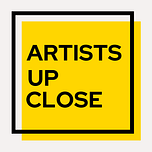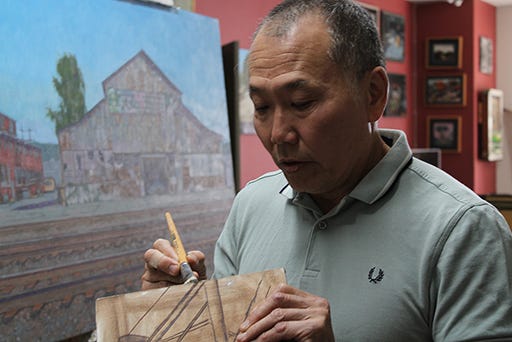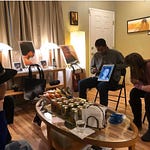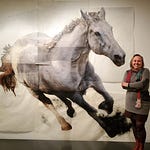In the heart of Seattle’s old Japantown, visual artist Keven Furiya is at home. Far from the tiny farming community — Versailles, Indiana — where he grew up in the 1960s and 70s, Keven spends his days painting the crumbling urban landscapes of SoDo, Pioneer Square, Georgetown, and Capitol Hill. Abandoned warehouses, disused factories, and neglected structures of all kinds dominate his latest series of work, Urban Textures. But for Keven, there’s a life lesson in the decay.
“Nothing lasts forever,” says Keven. “So, we might as well embrace it, and accept it, and then see the beauty in it.”
And the beauty is in the details: smooth cobblestones beneath crumbling asphalt, rusted and busted pipes, grit filled puddles reflecting the midday sun, and copper-toned railroad tracks that lead to long forgotten destinations.
“It adds another element to the visual fabric,” Keven says of the you-can-almost-feel-it textures he captures with such life-like precision in his oil paintings. “[It’s like] when you look at someone's face and you see wrinkles, you know that person has gone through life. You know, maybe they had a rough time about it, maybe not. But it's a badge of experience. It's a badge of surviving.”
Much of Seattle’s oldest architecture is disappearing, but Keven’s paintings serve as a vivid archeological record of what existed. “It seems like they always tear down the ones with the most character,” Keven says, “you know, all the brick masonry, the wear and tear, and the nice construction.” He points to the Frye Hotel across the street from his live/work loft, noting that the high quality craftmanship needed to build it isn’t as readily available today.
For the past 23 years Keven has made Pioneer Square his home. He arrived in 1999 when the neighborhood had hundreds of artists living and working in the 619 building, the Washington Shoe building, and the many studios squeezed above the bars on 1st avenue. The neighborhood was gritty back then (as always) but also vibrant, hopeful, and a great place for artists to connect to each other.
“It was really nice,” Keven says. “Whenever you would take a break or whenever you walked outside, you would bump into someone.”
Even First Thursdays was bigger with ample opportunities for artists to network. But then the dotcom boom arrived, and one-by-one artist homes, studios, and havens were sold off to the highest bidders so that tech workers (and all the ancillary businesses and professionals) would have high-end apartments and office space. And like all of the other artists, Keven was sent packing and eventually found a place at the Tashiro Kaplan Artists Lofts where he’s remained for more than 15 years.
I met Keven in 2017, he had two cats, a parrot, and a keen sense of historical perspective. His parents were immigrants from Japan. They had survived wartime scarcity so they instilled in Keven a kind of practicality rarely seen in artists.
“My dad said, ‘If you want to do these things, if you want to buy record albums, if you want Levi's instead of JC Penney's, get a job.’”
So, Keven and his two siblings all worked at a local grocery store where they funded their obsession with 1970s pop culture.
“When I got my driver's license, we would drive to Cincinnati, a bunch of friends and I, and then go see rock concerts,” Keven says.
He was a fan of the famous Seattle-based band Heart, and the other heavy metal and hair bands of the 70’s and 80’s such as Aerosmith and AC/DC. This era of music was known for its brave exploration of anxiety, depression, social isolation, and loneliness, and the willingness to peer into the darkness of life and make that experience empowering. I can see that adventurous and compassionate spirit in Keven’s rendering of decaying buildings and his approach to the artist life. He sees and portrays what others prefer to ignore. And he’s willing to face the more unpleasant aspects of life and the compromises you might make to survive. He was heavily influenced by his parents who survived the war.
“They do not glamorize poverty or being poor,” Keven says. “It's not a game. They both survived war-torn Japan. So, they know what it's like to not have any electricity, water, money, food. You know, having to go through rations, up to about 10 years after the war.”
His parents encouraged his art making. They took him to art museums, enrolled him in classes, and bought him art supplies like watercolor paints and pencils. But they didn’t want him to suffer financially. They had friends who had been incarcerated in American internment camps during World War II, and they feared it could all happen again. They wanted their son to have chance at survival, or escape if necessary. They encouraged him to pursue a more financially stable career while also pursuing art on the side. Keven eventually became an engineer while diligently improving his artist craft after work, on weekends, and during leaves from his job.
“There was a point in time where I came very close to ignoring their advice,” says Keven, “and just trying to give it a go. But there's not too many people that do it without having to have some kind of a side gig.”
Keven considers himself lucky to enter his semi-retirement years doing what he loves the most — his art — just as his father spent his retirement years gardening. But he says it wouldn’t have happened like that if it wasn’t for his mastery of time management. Keven could have easily wasted those post-work evenings and weekends and ended up starting from scratch today.
“I began taking time off from work a couple of years here and a couple of years there,” Keven says. “And then, in the mid-90s is when I started to really take things seriously. And my first show was in 1999.”
During an 18-month and 2-year voluntary layoff from Boeing in the 90s, Keven spent his days taking graphic design and illustration classes. And that was before computers so he had to learn the old ways. And then in the evenings he worked as a classroom monitor at Gage Academy of Art in exchange for free classes. Keven says that it’s all about putting in the time, energy and effort over the long-term. And understanding that has helped him maintained a routine of consistent improvement over the past 27 years.
“I don't keep one of those day timer things,” Keven says. “It's all in my head. And I always know: What do I have to do this afternoon? It's like playing chess.”
He credits his mastery of time management on the years he spent studying engineering. The study load was heavy, and anyone who didn’t have the skill to get it all done simply flunked out.
“Right now, a productive day is I get up and then I have to go through a lot of stretches, because of sciatica and arthritis in my hips, and then I'll go to the gym, that's really important,” says Keven. “Because, you know, getting older, and sciatica and arthritis isn't going to go away. And then when I get back from the gym, that's when I do most of my art, like the painting, you know, for about two or three hours. And then after that, after the temperature cools down, I check on the two gardens. And so yeah, it's spread out, but it's not like I do art eight hours a day. Basically, what I do is I set a segment, you know, a certain amount of time like, two, three, maybe four hours, (mostly two or three hours), but do it consistently. That's the key. It's not quantity, it's the quality, its consistency.”
I had visited Keven’s apartment about a dozen times before, but as he delved into the details of his routine for being a productive artist, I began to notice the numerous paintings neatly packed in crates, their edges organized by date going back as far back as 2003. And I wondered aloud how growing up in a small (less than 2,000 people) farm town had influenced his life paradigm.
“Cincinnati was one hour away, that was the closest city and that's where we would get our tofu and soybean sprouts, because there's a small community of Japanese there,” says Keven. “And my mom is a city girl. She was born and raised in Tokyo. So, we would go to Cincinnati, like once or twice a month and we'd go to Chicago, once or twice a year. … My mom looked forward to it, and we would dress up. You would dress up when you go to the city.”
The conversation quickly shifted to the architecture.
“Cincinnati had some really cool buildings,” Keven says. “It's on the Ohio River, so it was based on commerce. And the buildings were really cool — the griminess. It was kind of clean, but there's some grime to it.”
When in Cincinnati, Keven and his family visited a Japanese grocery (which eventually became a tofu processing plant) owned by the Yamaguchi family who had spent time incarcerated in an American internment camp during World War II. Keven’s dad would bring Japanese produce such as cabbage, radish, eggplant and cucumbers from his garden, and the Yamaguchis would give them tofu in exchange, which at the time was impossible to find in Indiana. He recounted the grungy concrete walls of the basement grocery and the powerful aroma of Asian food and spices. The outings to Cincinnati were an opportunity to reconnect to Japanese culture but also a respite from being the only family of Japanese descent in Versailles.
“I was lucky,” Keven says. “Had it been 10 years earlier, it would have been tougher, racially. There would have been more harassment. Because, you know, the Japanese were the Arabs of that time. Because when I was born, it was like 21 years after Pearl Harbor. And the Japanese treated their POWs horribly, so there was bitterness. But by the time I was in high school, I was never hassled by my classmates, or the people two or three years above me. … But you know, you still knew your place, and you still knew that you're different. And you were always reminded of that. … You're like a mascot. You have different nicknames: like, hopsing, you know, based on pop culture, Chinaman, grasshopper, long duk dong (that was from 16 Candles). And it's not malicious. They didn't know better. But it wasn't like a torrent. I had some really good friends. They were really close. And they were very protective. And I was the oldest so that protection sort of covered my brother and sister. But yeah, we were the only ones. It was tougher on my sister, definitely.”
Before moving to Seattle, Keven had an incomplete understanding about Asian American history and he hadn’t met other Asian artists.
“When I came up here, and I met a lot of Asian Americans that were born and raised up here, they seemed so sure of themselves, and very assertive, and, and they didn't take shit,” Keven says. “They were very outspoken, they were vocal. Whereas, you know, if you're in a town where there aren't too many, you keep quiet, you don't want to be noticed. You don't make waves. You deescalate. These Asians out here, they're different. And then the ones that are from Hawaii, I just admire that they're just so sure of themselves. I'm sure they had insecurities, but they did a lot better of a job hiding it than if you're the only person. You could say things and get away with being more out here, as opposed to if you're the only one.”
It wasn’t until about 10 years ago that Keven began contemplating how his experience as a Japanese American influenced his art. He was visiting a Kamekichi Tokita and Kenjira Nomura exhibition at the Seattle Asian Art Museum when it occurred to him just how expansive Asian art could be.
“I always likened the Asian art as the porcelain or the calligraphy,” Keven says. “But to see those two, you know, see the very Western oil paintings. I really admired that. Like, ‘hey it's art by Japanese, Japanese Americans, and it's not calligraphy, and it's not like porcelain.”
Keven Furiya’s second solo exhibition, Urban Textures, will show at Vermillion from October 13, 2022 to November 4, 2022. The exhibition is free and open to the public.
















